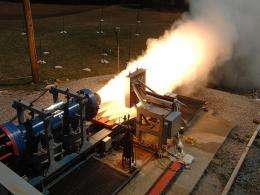NASA sub-scale solid-rocket motor tests material for space launch system

(PhysOrg.com) -- A sub-scale solid rocket motor designed to mimic NASA's Space Launch System, or SLS, booster design successfully was tested today by engineers at NASA's Marshall Space Flight Center in Huntsville, Ala. The 20-second firing tested new insulation materials on the 24-inch-diameter, 109-inch-long motor. The motor is a scaled down, low-cost replica of the solid rocket motors that will boost SLS off the launch pad.
Marshall is leading the design and development of the SLS on behalf of the agency. The new heavy-lift launch vehicle will expand human presence beyond low-Earth orbit and enable new missions of exploration across the solar system.
The test will help engineers develop and evaluate analytical models and skills to assess future full-scale SLS solid rocket motor tests. The next full-scale test, Qualification Motor-1 (QM-1), is targeted for spring 2013. Two five-segment solid rocket motors, the world's largest at 154-foot-long and 12-foot diameter, will be used in the first two 70-metric-ton capability flights of SLS.
Watch the test fire video below:
Previous ground tests of the motors included carbon insulation to protect the rocket's nozzle from the harsh environment and 5000-degree temperatures to which it is exposed. QM-1 will include a new insulation material, provided by a new vendor, to line the motor's nozzle.
"Test firing small motors at Marshall provides a quick, affordable and effective way to evaluate the new nozzle liner's performance," said Scott Ringel, an engineer at Marshall and the design lead for this test. "We have sophisticated analytic and computer modeling tools that tell us whether the new nozzle insulation will perform well, but nothing gives us better confidence than a hot-fire test."
The test also includes several secondary objectives. The team introduced an intentional defect in the propellant with a tool designed to create a specific flaw size. By measuring the temperature inside the motor at the flaw location, the team hopes to gain a better understanding for the propellant's margin for error. Test data also will help the team better understand acoustics and vibrations resulting from the rocket motor's plume.
In addition, NASA's Engineering and Safety Center will use test data to measure a solid rocket motor's plume and how it reacts to certain materials.
Engineers from Marshall's Engineering Directorate designed the test motor with support from ATK Aerospace Systems of Huntsville, Ala. ATK of Brigham City, Utah, the prime contractor for the SLS booster, is responsible for designing and testing the SLS five-segment solid rocket motor.
More information: For more information about SLS, visit: www.nasa.gov/sls
Provided by JPL/NASA



















